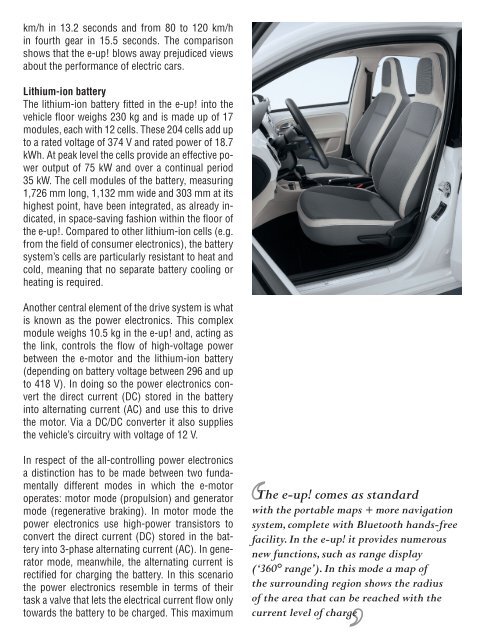Cars GlobalMag October 2013
Cars GlobalMag October features all the new cars presented at the Frankfurt Auto Show. The concept cars presented in Germany deserve a special chapter with a beauty contest of their own. CGM October also features a focus on the new Peugeot 308, Volkswagen e-up! electric cars, the racing spectacle of the NASCAR Whelen Euro Series ... and much more!
Cars GlobalMag October features all the new cars presented at the Frankfurt Auto Show. The concept cars presented in Germany deserve a special chapter with a beauty contest of their own. CGM October also features a focus on the new Peugeot 308, Volkswagen e-up! electric cars, the racing spectacle of the NASCAR Whelen Euro Series ... and much more!
You also want an ePaper? Increase the reach of your titles
YUMPU automatically turns print PDFs into web optimized ePapers that Google loves.
km/h in 13.2 seconds and from 80 to 120 km/h<br />
in fourth gear in 15.5 seconds. The comparison<br />
shows that the e-up! blows away prejudiced views<br />
about the performance of electric cars.<br />
Lithium-ion battery<br />
The lithium-ion battery fitted in the e-up! into the<br />
vehicle floor weighs 230 kg and is made up of 17<br />
modules, each with 12 cells. These 204 cells add up<br />
to a rated voltage of 374 V and rated power of 18.7<br />
kWh. At peak level the cells provide an effective power<br />
output of 75 kW and over a continual period<br />
35 kW. The cell modules of the battery, measuring<br />
1,726 mm long, 1,132 mm wide and 303 mm at its<br />
highest point, have been integrated, as already indicated,<br />
in space-saving fashion within the floor of<br />
the e-up!. Compared to other lithium-ion cells (e.g.<br />
from the field of consumer electronics), the battery<br />
system’s cells are particularly resistant to heat and<br />
cold, meaning that no separate battery cooling or<br />
heating is required.<br />
Another central element of the drive system is what<br />
is known as the power electronics. This complex<br />
module weighs 10.5 kg in the e-up! and, acting as<br />
the link, controls the flow of high-voltage power<br />
between the e-motor and the lithium-ion battery<br />
(depending on battery voltage between 296 and up<br />
to 418 V). In doing so the power electronics convert<br />
the direct current (DC) stored in the battery<br />
into alternating current (AC) and use this to drive<br />
the motor. Via a DC/DC converter it also supplies<br />
the vehicle’s circuitry with voltage of 12 V.<br />
In respect of the all-controlling power electronics<br />
a distinction has to be made between two fundamentally<br />
different modes in which the e-motor<br />
operates: motor mode (propulsion) and generator<br />
mode (regenerative braking). In motor mode the<br />
power electronics use high-power transistors to<br />
convert the direct current (DC) stored in the battery<br />
into 3-phase alternating current (AC). In generator<br />
mode, meanwhile, the alternating current is<br />
rectified for charging the battery. In this scenario<br />
the power electronics resemble in terms of their<br />
task a valve that lets the electrical current flow only<br />
towards the battery to be charged. This maximum<br />
The e-up! comes as standard<br />
with the portable maps + more navigation<br />
system, complete with Bluetooth hands-free<br />
facility. In the e-up! it provides numerous<br />
new functions, such as range display<br />
(‘360° range’). In this mode a map of<br />
the surrounding region shows the radius<br />
of the area that can be reached with the<br />
current level of charge




